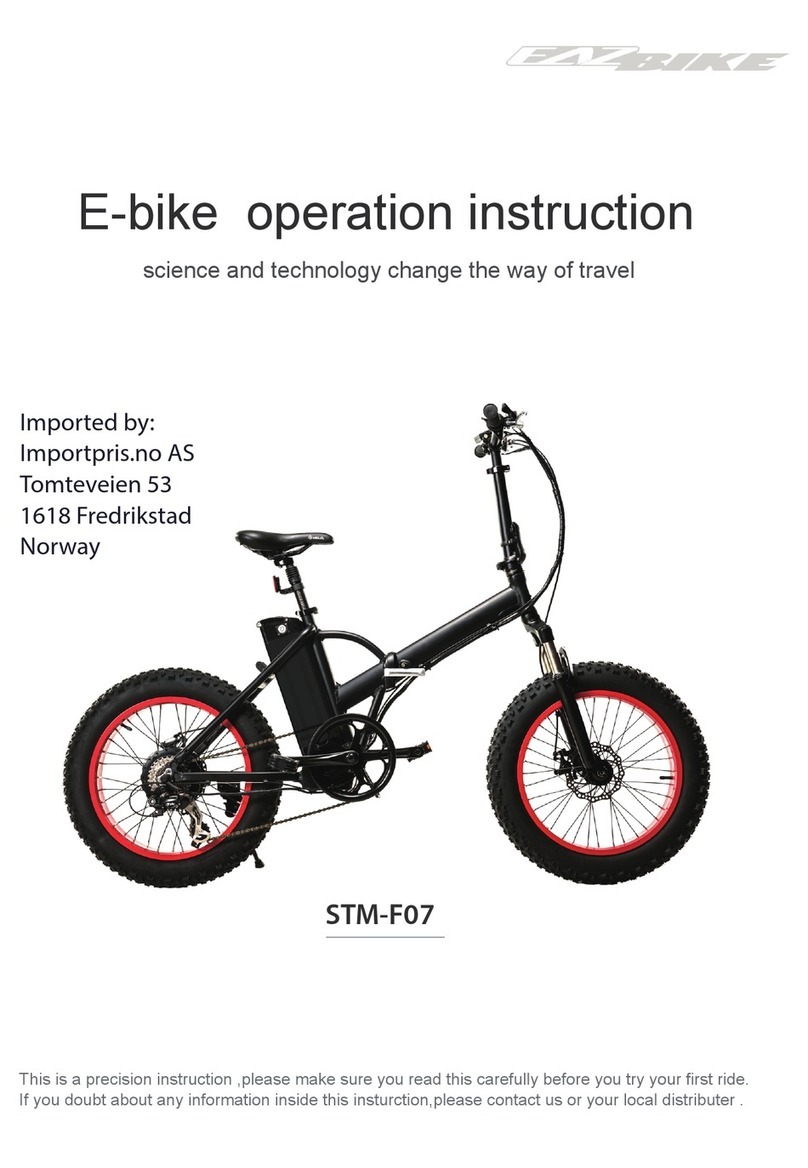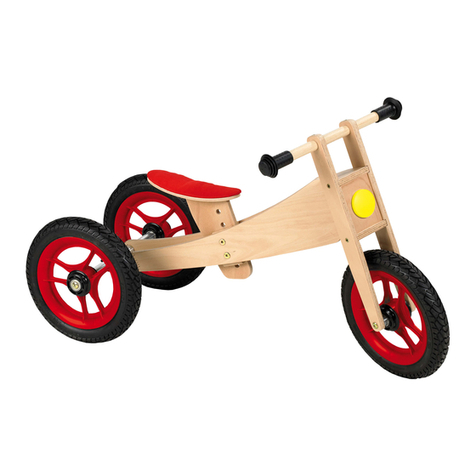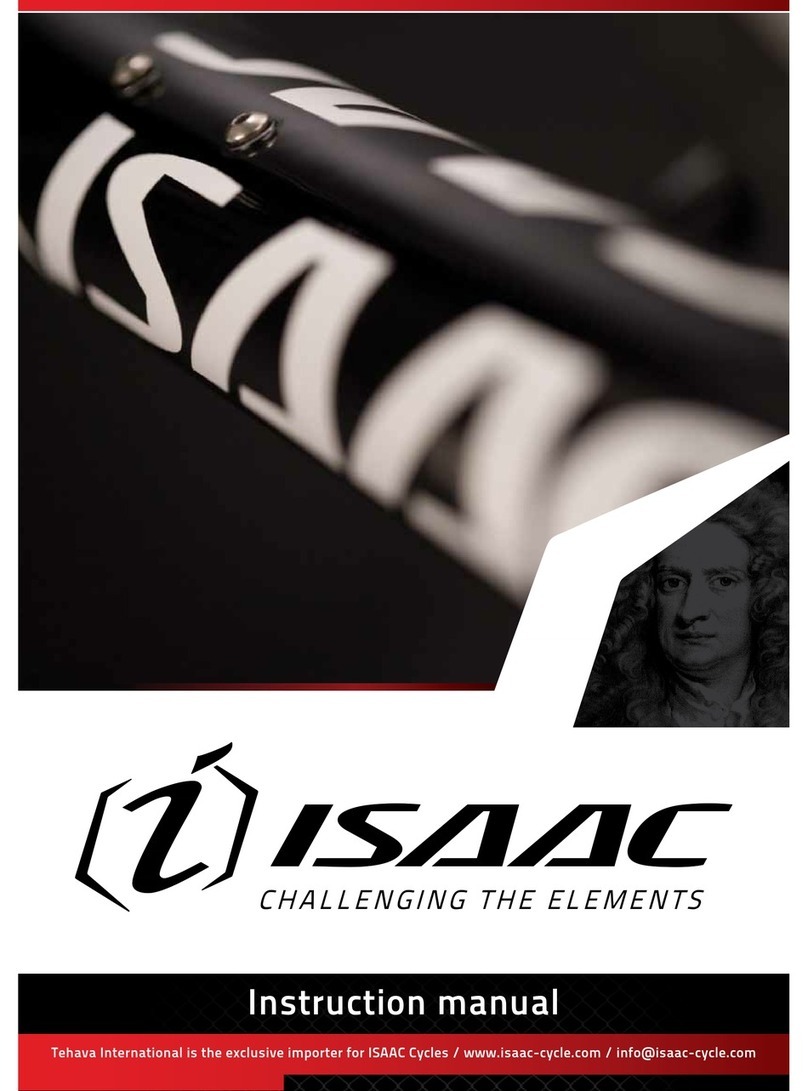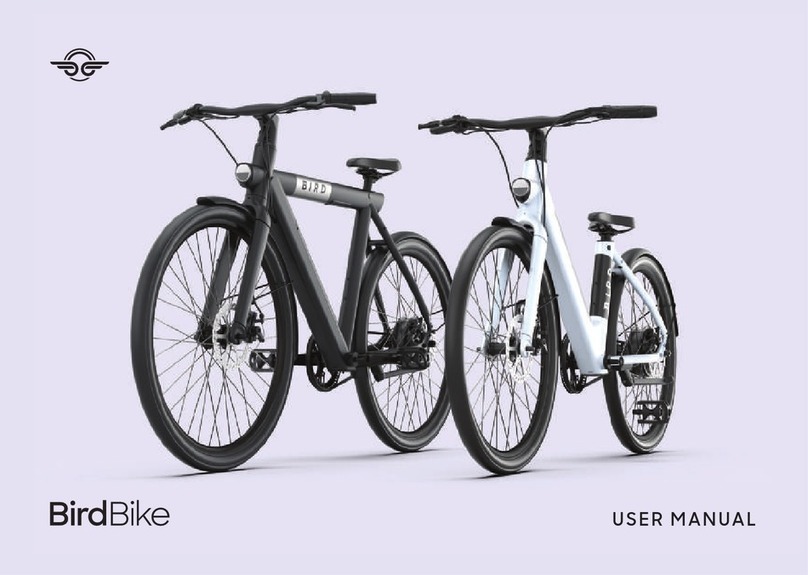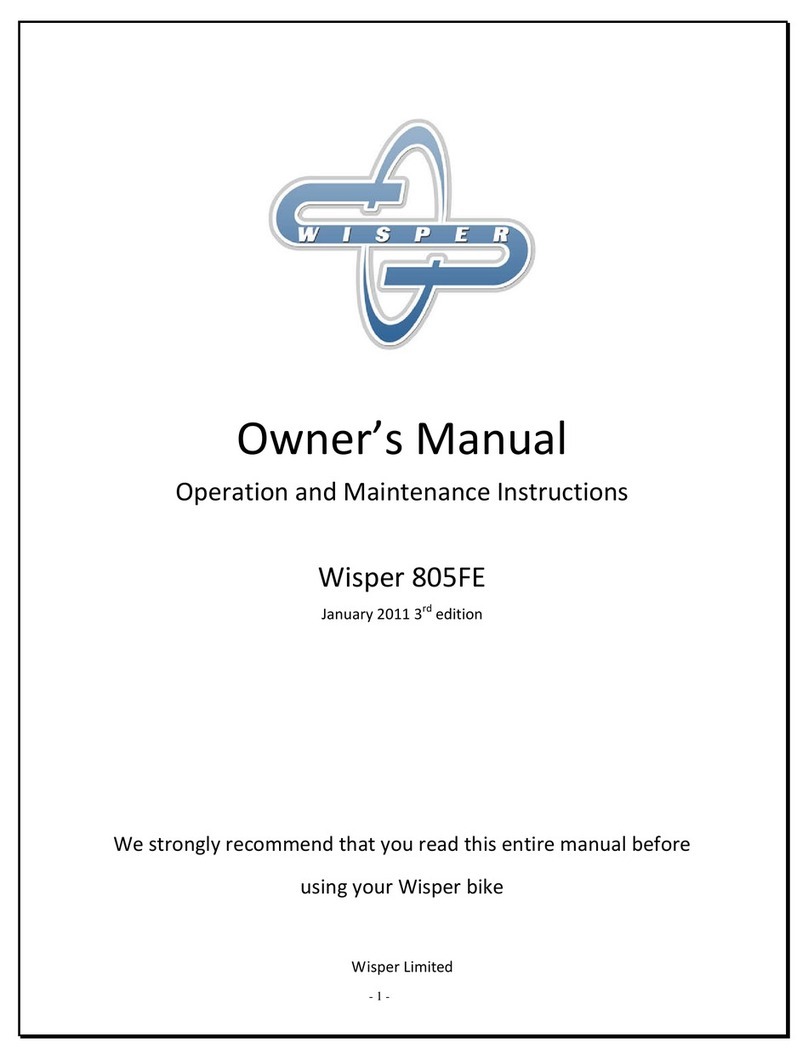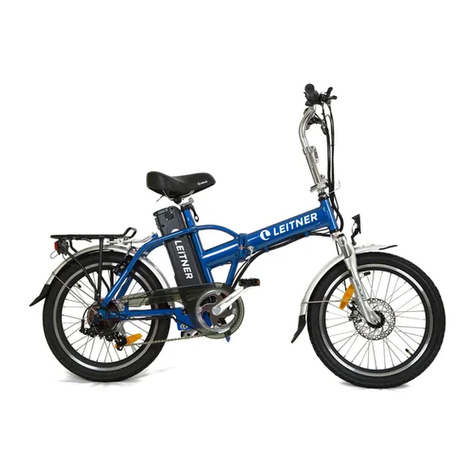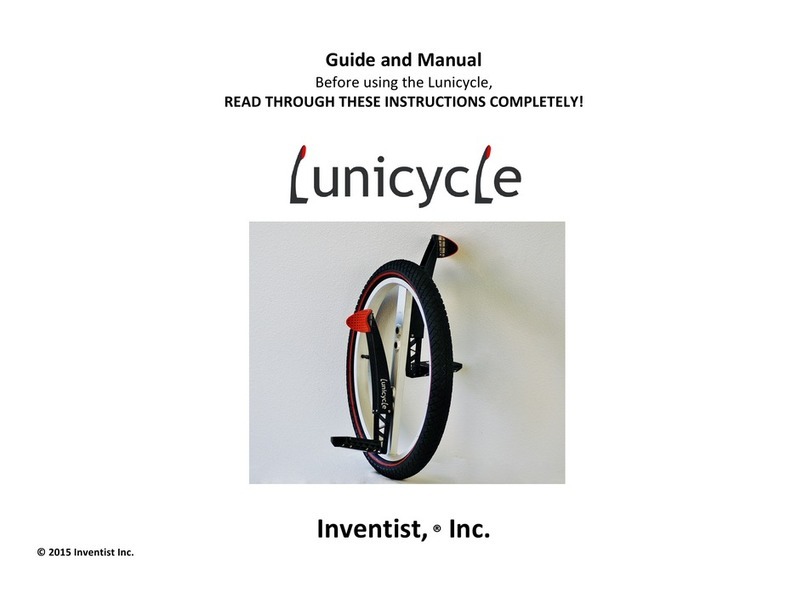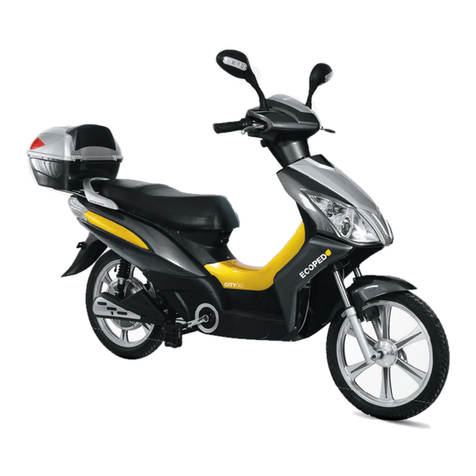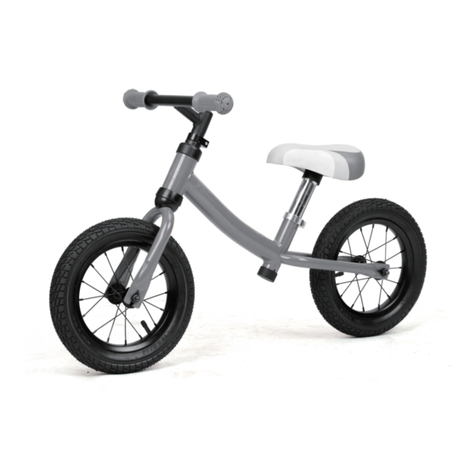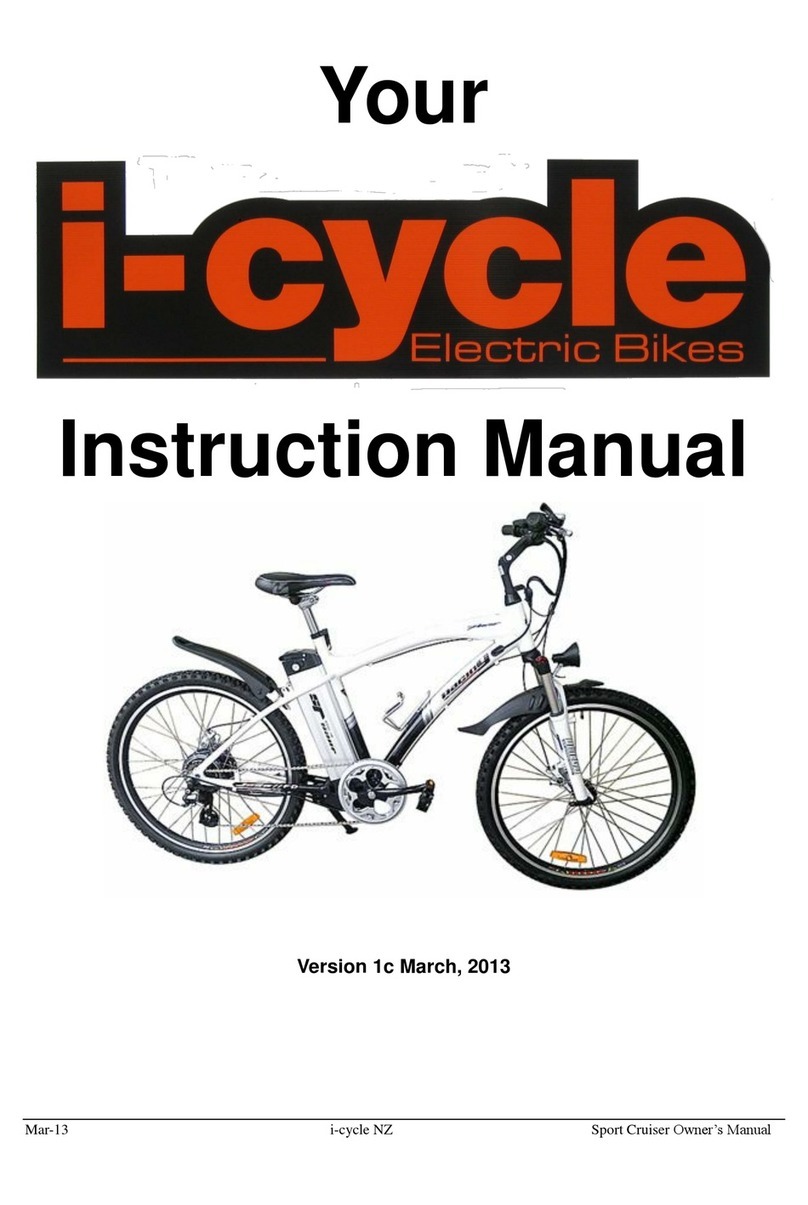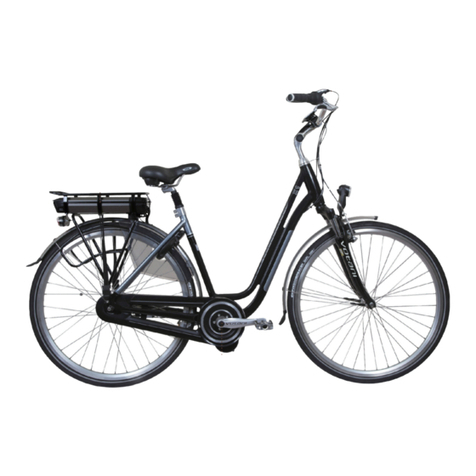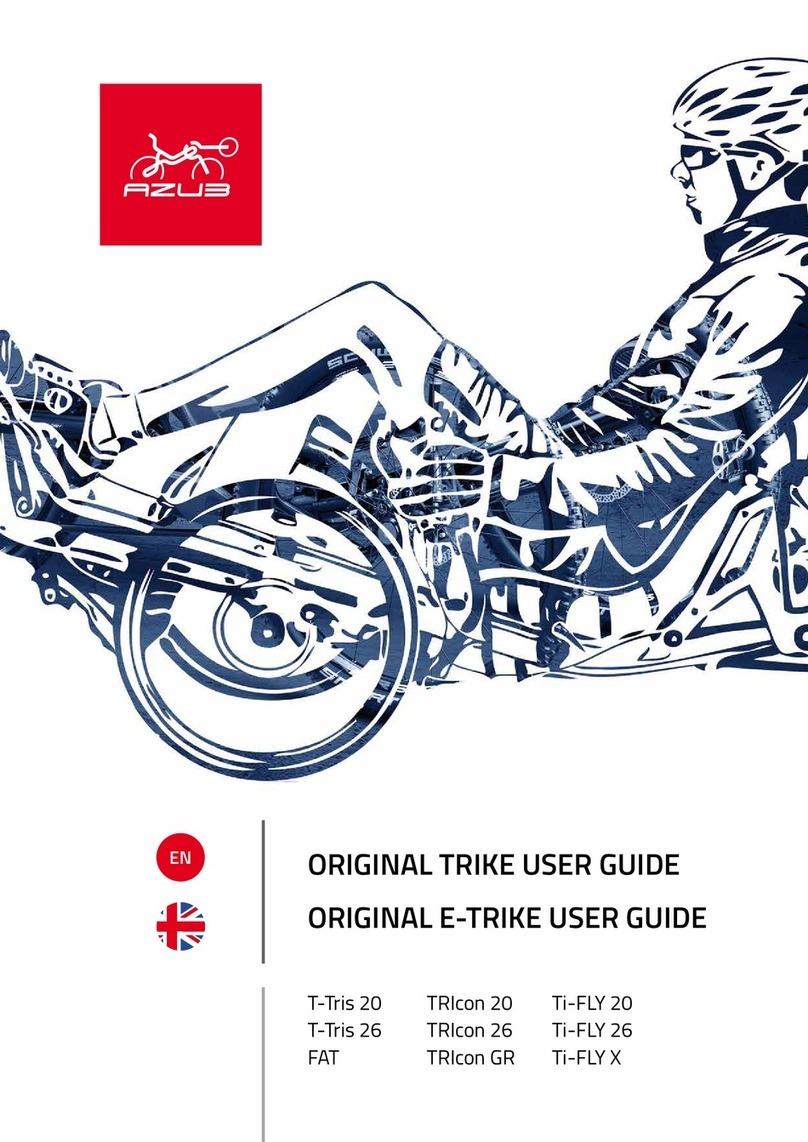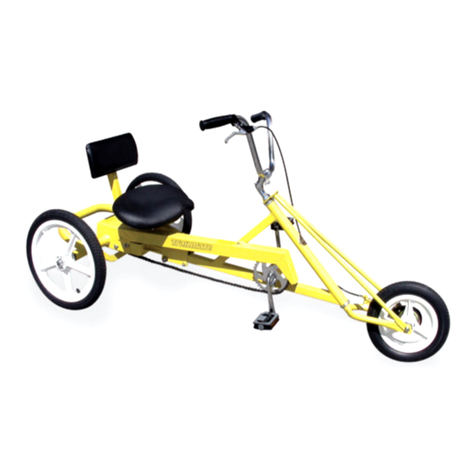ENVO E-Bike User manual

ENVO E-bike User’s Manual
1
ENVO E-Bike Users’ Manual

ENVO E-bike User’s Manual
2
INTRODUCTION..........................................................................................................................................................................................2
INSTALLATION............................................................................................................................................................................................3
WARNINGS AND CAUTION STATEMENTS ..................................................................................................................................................5
Battery .....................................................................................................................................................................................................11
1. Charging Your Battery.................................................................................................................................................................11
2. Battery Position on the Bike: ......................................................................................................................................................12
3. Battery and Charger Care ...........................................................................................................................................................14
4. Battery Range: ............................................................................................................................................................................14
5. Battery Maintenance & Safety: ..................................................................................................................................................15
6. Battery Transport:.......................................................................................................................................................................15
7. Battery Disposal:.........................................................................................................................................................................15
8. Fuse:............................................................................................................................................................................................16
Interface...................................................................................................................................................................................................16
1. Quick Start Guidelines for Using Pedal Assist: ............................................................................................................................17
2. Activating Head and Tail lights:...................................................................................................................................................18
3. Pedal Assist Mode –Detailed Instructions for Use:....................................................................................................................18
4. Hand Throttle Control:................................................................................................................................................................18
Brakes ......................................................................................................................................................................................................19
1. Brake Check: ...............................................................................................................................................................................19
2. Disc Brakes:.................................................................................................................................................................................19
3. Brake Controls and Features:......................................................................................................................................................20
4. Brake Disconnect Switch:............................................................................................................................................................20
5. A2 HYDRAULIC DISC BRAKE ASSEMBLEY and MAINTENANCE: ...................................................................................................20
Motor:......................................................................................................................................................................................................26
Gears:.......................................................................................................................................................................................................27
Cassette sprocket:....................................................................................................................................................................................27
Tire and Wheel Safety:.............................................................................................................................................................................27
Bike Fit: ....................................................................................................................................................................................................29
Stem, Handle Bars, Ends and Grips:.........................................................................................................................................................29
Bolts and Nuts:.........................................................................................................................................................................................30
Saddle: .....................................................................................................................................................................................................30
Pedals:......................................................................................................................................................................................................31
Kickstand:.................................................................................................................................................................................................32
Keys:.........................................................................................................................................................................................................32
General: ...................................................................................................................................................................................................32
TROUBLESHOOTING.................................................................................................................................................................................34
ELECTRIC BIKE FAQS.................................................................................................................................................................................39
THE LIFESPAN OF YOUR ELECTRIC BIKE AND ITS COMPONENTS .............................................................................................................40
Warranty..................................................................................................................................................................................................40
Warranty Terms.......................................................................................................................................................................................41
INTRODUCTION
Thank-you for choosing an ENVO Electric Bike. Our number one focus is to make you aware of the dangers of riding a
bicycle and especially an electric bicycle so you can ensure you have safe and enjoyable riding experiences for years to
come.
IMPORTANT: Please read this manual in its entirety before riding your bike or allowing anyone else to ride your bike. All
others should read this manual before you allow them to ride your bike without your supervision.

ENVO E-bike User’s Manual
3
If you have any concerns, questions or suggestions about your electric bike, please contact us at info@EbikeBC.com
Again, thanks for choosing ENVO Electric Bike!
INSTALLATION
There are 6 pieces in your package as shown in below pictures:
-Main body, wire-attached handle bar, mounted rear wheel, mounted headlight,
-Front Wheel,
-Saddle,
-Charger and Pedals in separate carton box,
-Panier,
Please take the necessary measure when you want to pull out the main frame, it is the heaviest part and the handle bar is attached
just by some wires and you have to protect the connections.
Step 1: Mount the front wheel in the direction where the disc brakes can fit inside.
Do not squeeze the brake during unboxing or any time before you mount the front wheel, otherwise refer to “Brake part 5”of the
manual.
Step 2: Stand up the bike on the kick stand and adjust the height of kick stand using the screw on the back side of the kick stand to
reach to the right size of the standing bike.
Step 3: Loosen the 4 bolts on the stem and then mount the handle bar on the bracket. You can firstly align the handle bar on the
right position before you fasten the bolts.
Please do not fasten one bolt and then go to the other but you must fasten all of them together gradually.

ENVO E-bike User’s Manual
4
The one single bolt in the stem is just to adjust the final height of handle bar as soon as you install all the components and wat to
ride the bike.
Step 4: Make sure that you read the pedal direction before you mount them. There is “L”or “R”engraved on the pedal.
Mount the right pedal on the right stand. You must apply some grease on the pedal screw to get the best performance
and durability.
Step 5: If you want to use the pannier you can place it on the rack and attach its belts to the right position. In any case
make sure that you attach the two bars of the rack to its place and fasten the two bolts.
Step 6: Mount the saddle on its position and fasten the sit clam just when you adjust the seat to the desired height and
direction.
Step 7: When you mount the full charged battery (read the battery topic first), check the display, headlight, Pedal Assist
levels and the throttle before you ride your bike.
Make sure that the rear wheel is not on ground when you want to check the throttle.

ENVO E-bike User’s Manual
5
WARNINGS AND CAUTION STATEMENTS
Electric Bikes can be dangerous to use. The user or consumer assumes all risk of personal injuries, damage, or
failure of the bicycle or system and all other losses or damages to themselves and others and to any property
arising out of or as a result of using the bicycle.
As with all mechanical components, your bicycle is subjected to wear and high stresses. Different materials and
components may react to wear or stress fatigue in different ways. If the design life of a component has been exceeded, it
may suddenly fail, possibly causing injuries to the rider. Any form of crack, scratches or change of coloring in highly
stressed areas indicate the life of the component has been reached and should be replaced.
If you have an impairment or disability such as visual impairment, hearing impairment, physical impairment,
cognitive/language impairment, and/or a seizure disorder, consult your physician before riding our bikes.
For replacement parts, technical information and warranty assistance, please contact:
info@EbikeBC.com
PLEASE NOTE: THIS MANUAL IS NOT INTENDED AS A DETAILED USER, SERVICE, REPAIR OR MAINTENANCE
MANUAL. PLEASE SEEK ASSISTANCE FROM A QUALIFIED TECHNICIAN FOR SERVICE, REPAIRS OR
MAINTENANCE. YOUR INSURANCE POLICIES MAY NOT PROVIDE COVERAGE FOR ACCIDENTS INVOLVING THE
USE OF THIS BICYCLE. TO DETERMINE IF COVERAGE IS PROVIDED YOU SHOULD CONTACT YOUR
INSURANCE COMPANY OR AGENT. DO NOT DISASSEMBLE, MODIFY OR REPLACE ELECTRICAL PARTS.
This manual contains many “Warnings” and “Cautions” concerning the consequences of failure to maintain or
inspect your bicycle and of failure to follow safe cycling practices.
The Caution symbol (above) can be seen throughout this Manual, and indicates a potentially hazardous situation
which, if not avoided, could result in serious injury or death, or is an alert against unsafe practices.
Many of the Warnings and Cautions say, “You may lose control and fall.” Because any fall can result in serious
injury or even death, we do not always repeat the warning of possible injury or death, and if we do not, please
assume this is the case, as all bicycles, including electric bikes, are dangerous and their safe use requires
constant and consistent maintenance and care.
Please ensure that prior to each and every ride (without exception), each electric bike rider reviews the safety
requirements enumerated throughout this Manual, and if any problems are observed, they should be resolved
prior to use.
Because it is impossible to anticipate every situation or condition which can occur while riding, this Manual
makes no representation about the safe use of this Electric Bike under all conditions. There are risks associated
with the use of any bicycle which cannot be predicted or avoided, and which may be caused and/or prevented
through the actions of the rider, and which are the sole responsibility of the rider.
You should save this Manual along with any other documents that were included with your bicycle purchase for
future reference, including the manuals provided by the manufacturers of the motor, battery and any other

ENVO E-bike User’s Manual
6
components. You should read and become familiar with the contents of these additional manuals as well before
riding your bicycle.
All content in this Manual is subject to change or withdrawal without notice.
Visit https://EbikeBC.com to download the latest version.
EbikeBC assumes no responsibility or liability for any errors or inaccuracies that may inadvertently appear
herein.
LEGALITY
In the Canada, electric bikes are defined as “a two- or three wheeled vehicles with fully operable pedals and an
electric motor of less than 500 watts (0.67hp) whose maximum speed of 32Km/hr.
Local and state regulations vary. It is your responsibility to ensure your bike is legal in your particular area before
riding it on public roads. If you’re unsure, ask your bicycle bike mechanic for more information about local laws and
regulations.
GENERAL SAFETY
When operating your bike, it is critical that you know how to properly care for each part or your bike as well as
your bike as a whole. Please ensure you have familiarized yourself with all aspects of your bike functions and
operations before riding it –ESPECIALLY on the open road with other traffic.
Since Electric Bikes are VERY different from regular bikes please be sure to read the section on “RIDING
ELECTRIC BIKES” as well as this entire manual.
NEVER operate your bicycle when you are under the influence of alcohol or drugs, including prescribed or
over the counter medications.
Always Ride at a speed appropriate for the conditions. High speed means higher risk.
It is your responsibility to familiarize yourself and comply with the applicable within the country, state, county, province
and/or city where you will be riding.
Be careful to keep your body parts and other objects away from the sharp teeth of the chain rings, the moving chain, the
turning pedals and the crank, and the spinning wheels of your bicycle.
USE –BEACH CRUISER:
ENVO Electric bikes are designed to be ridden on paved roads or light trails only. The bike is not designed to withstand
off-road conditions or downhill terrain. EBIKEBC assumes no liability for any accident, injuries, or property damage
incurred as a result of rider’s use or misuse of EBIKEBC bicycles, including any damages resulting from or arising out of
off-road usage.
An Electric Bike is not a mountain bike, racing bike, or BMX bike –Riders who do jumping, stunts, wheelies, and bike
tricks should never be on this bike and can cause harm to themselves and others
- and putting undue, unintended or unnecessary stress on the bike parts, frame, brakes handle bars, stem, or forks can
cause these components and/or the bike to fail, causing serious injury or death. DO NOT USE THIS BIKE FOR

ENVO E-bike User’s Manual
7
JUMPING over curbs, riding on mountainous or off-road trails, or any use other than for commuting and cruising in a
relaxed, safe manner. Never exceed 20 miles per hour on this bike.
SINGLE RIDER ONLY:
ENVO Electric bikes are designed for one passenger only. DO NOT carry any additional passengers on the front or rear
of the bike. The rear rack holding the battery is not designed to carry the weight of any additional passengers, except a
baby carrier with maximum load of 40 pounds. Standing, kneeling, or sitting backwards or sideways (both legs on the
same side of the bike) on the carrier seat while the bike is moving or stopped can easily result in broken limbs, loss of
control of the bike, destroyed rims, a destroyed bike frame, or worse.
WEIGHT CAPACITY:
ENVO Electric Bike are designed with a maximum weight capacity of 120KG or 250 pounds for all models. The rear rack
maximum weight capacity of a is 20KG or 44 pounds. Exceeding the maximum weight capacity can result in damage to
the bike, which can lead to serious injury or death.
CARRYING CARGO:
Carrying a load require getting accustomed to. Practice maneuvering and braking on a flat, hazard and traffic free street
with and without a load before going out into the world. Carrying a seated passenger or heavy load involves risks,
foremost of which can be decreased braking power and increased stopping distance. The maximum weight capacity is
310lbs (140 kg) shared between the rider and cargo.
VEHICLE RACKS:
Misuse of vehicle racks could result in a potential hazardous situation which, if not avoided, could result in serious
injury or death. Be sure to read and follow the instructions provided by the rack manufacturer for more complete
information.
Always remove battery from bike frame when using a vehicle rack.
PEDAL ASSIST:
When you are in PAS mode –Do not pedal around corners –you will get a boost and your pedal will hit the ground
and can cause injury or death!
Do not use pedal assist on level and downhill grades if people are visible on the path or boardwalk.
Do not use pedal assist if small children or pets are within 100 feet.
HELMET USAGE:
Always wear an approved helmet and ensure it fits according to the manufacturers’ instructions.
Ensure your helmet meets the latest certification standards and is appropriate for the type of
riding you do –and if there are any special requirements for riding an electric bike.
Most serious bicycle injuries involve head injuries, which might have been avoided if the rider had worn an
appropriate helmet. FAILURE to wear a helmet when riding may result in serious injury or death.
MECHANICAL SAFETY CHECK:
Check the condition of your Electric Bike before every ride.
Make sure no nuts, bolts or fixings are loose, and pay attention to the axle, nuts and handlebar stem.
Make sure the tires are correctly inflated with the recommended air pressure, which can be found on the rim of
every tire.
Check the brakes for proper operation.

ENVO E-bike User’s Manual
8
SMALL BICYCLE ACCESSORIES AND CHOKING HAZARD:
Some Bicycle accessories may present a choking hazard and other hazard to small children. Keep any bike parts
accessories, tools away from small children.
TECHNICAL SUPPORT: It is important to your safety, performance and enjoyment to understand how things work on
your bike. We urge you to ask your bike mechanic how to fix the things described in this section before you attempt them
yourself, and that you have your bike mechanic check your work before you ride the bike. If you have even the slightest
doubt as to whether you understand something in this section of the Manual, talk to your bike mechanic or qualified
mechanic- or do not ride your bike!
USING GOOD JUDGMENT:
Make sure no straps are dangling where they could get caught in the wheels –No bags, boxes or any items should be
placed in a position where they could get caught in the spokes Double check your load for security and stability. Check
to see that your wheels are securely fastened and that no components or frame members are cracked or broken (in
general, if at any time you notice a crack or bend in your bike, stem, forks, or bars of your bicycle, stop riding
immediately; take your bike to your local bike shop and have them inspect it).
WARNING: A SPECIAL NOTE TO PARENTS
IN CANADA, ELECTRIC BIKES MAY ONLY BE RIDDEN BY PERSONS 16 YEARS OLD AND OLDER!!!
IT IS ILLEGAL FOR INDIVIDUALS YOUNGER THAN 16 TO RIDE ELECTRIC BICYCLES.
As a parent or guardian, you are responsible for the safety of your adolescent when riding a bicycle.
To maximize the safe use of the bicycle by an adolescent, EBIKEBC strongly advises you to read this
Manual in its entirety, and practice the following precautionary guidelines (1):
Understand and obey not only the applicable local motor vehicle, bicycle and traffic laws, but also adhere to
common sense rules of safe and responsible bicycling.
Make sure the bicycle is properly fitted to the adolescent.
Make sure the bicycle is always in good repair and safe to operate.
Make sure that you and your adolescent have learned and understand how to safely operate an electric bicycle
and are familiar with the roads and/or other terrain upon which the bike will be ridden.
Make sure your adolescent always wears an approved bicycle helmet when riding (2).
Failure to follow the aforementioned warnings could result in serious injury or death.
1EBIKEBC assumes no liability for failure to comply with the stated guidelines.
2Make sure your adolescent understands that a bicycle helmet is for bicycling only and must be removed when not
riding. A helmet must not be worn while playing in play areas, including playground equipment, etc.

ENVO E-bike User’s Manual
9
Highlighted Safety Rules:
1. Obey the Rules of the Road and all traffic Laws.
2. Remember that you are sharing the road or path with others –motorists, pedestrians and other cyclists.
Respect their rights.
3. Ride defensively. Always assume that others do not see you.
4. Look ahead, and be ready to avoid the following:
Vehicles slowing or turning, entering the road or lane ahead of you, or coming behind you
Parked car doors opening
Pedestrians stepping onto the road or path
Children or pets playing near the road
Pot holes, sewer grating, railroad tracks, expansion joints, road or sidewalk construction, debris and other
obstructions that could cause you to swerve into traffic, catch your wheel or cause you to have an accident
Miscellaneous other hazards and distractions which can occur on a bicycle ride
5. Ride in the designated bike lane, on designated bike paths or as close to the edge of the road as possible, in the
direction or traffic flow or as directed by the local governing law.
6. Stop at the stop signs and traffic lights, slow down and look both ways at intersections. Remember that a bicycle
always loses in a collision with a motor vehicle, so be prepared to yield even if you have the right of way.
7. Use approved hand signals for turning and stopping.
8. Wear proper attire, including bright clothing, protective glasses and sturdy shoes. Never wear a loose-fitting dress or
long dress when riding –it can get caught in the moving parts of the bike and cause serious injury or even death.
9. Never ride with headphones. They mask traffic sounds and emergency vehicles sirens, distract you from
concentrating on what is going on around you, and their wires can tangle in the moving parts of the bicycle, causing
you to lose control.
10. Never carry a passenger, unless it is a small child weighing less than 40 pounds whom you feel comfortable carrying
on a bike, can maintain head control and absorb the stresses felt on a bike ride. Ensure the child is wearing an
approved helmet, appropriate clothing for the ride and is secured in a correctly mounted child carrier or a child carrier
trailer. The child seat that attaches to the EBIKEBC bikes is for side walk and board walk riding only and should never
be used on the open road where there is a chance or an accident with a car or other moving vehicles. Never exceed
15 miles per hour when you are carrying a child on the back seat, or 20 miles per hour when having a child in an
approved child trailer.
11. Never carry anything that obstructs your vision or your complete control of the bicycle, or which could become
entangled in the moving parts of the bike.
12. Never hitch a ride by holding on to another vehicle or bike.
13. Do not weave through traffic or make any moves that may surprise people with whom you are sharing the road.
14. Observe the right of way.
15. Avoid riding in bad weather, when visibility is obscured, at dawn, dusk or in the dark, or when extremely tired.
Each of these conditions increases the risk of accident.
16. Always bring some form of identification when riding. Also bringing cash can be helpful.
17. Yield right of way to pedestrians and animals.
18. Signal with voice or bell when passing.
19. Walk your bike up or down access ramps or whenever you feel uneasy, unsure or unsafe.
20. Maintain a minimum of 10 feet behind the bike in front of you.
21. Be aware that your extra speed, and extra weight of the bike mean you must be more careful, especially around other
trail users.

ENVO E-bike User’s Manual
10
22. Wet weather impairs traction, braking and visibility, both for the bicyclist and for other vehicles sharing the road.
The risk of an accident is dramatically increased in wet conditions.
23. Wet weather may lessen the grip of the rider’s feet on the pedals. If your feet slip off the pedals, it could lead you to
fall.
24. Night Riding –Riding your bike at night is much more dangerous than riding during the day. Adolescents or
inexperienced bike riders should never ride at dawn, at dusk or at night. Adults who choose to accept the increased
risk of riding at these times need to take extra care both riding and choosing specialized equipment, which can help
to reduce that risk. When riding at night or in other hazardous conditions –RIDE SLOWLY –no more than 10 miles
per hour.
25. Consult your local authorized bike shop or bike mechanic about night riding and safety equipment.
26. Reflectors are not a substitute for required lights. Riding at dawn, at dusk or at night or at other times of poor
visibility without adequate bicycle lighting systems and without reflectors is dangerous and may result in serious
injury.
27. Check reflectors and their mounting brackets regularly to make sure that they are clean, straight, unbroken and
securely mounted. Have your bike mechanic replace damaged reflectors and straighten or tighten any that are bent or
loose.
28. Do not remove the front or rear reflectors or reflector brackets from your bike. They are an integral part of the
bicycle safety system. Removing the reflectors reduces your visibility to others using the roadway.
29. Make sure your bicycle has and always is equipped with correctly positioned and securely mounted
reflectors.
30. ALWAYS wear a helmet, closed toe shoes and eye protection when riding.
31. Electric bikes are considerably heavier than normal bicycles. For this reason, parking, pushing, lifting and carrying
the bike is more difficult. Bear this in mind when loading your bike into a car and unloading it, or when mounting in
ton a bicycle carrier system.
32. Never ride at a speed outside your comfort zone, or that you feel may be unsafe for the given conditions.
33. When mounting your bike, make sure not to step on the pedals until you are sitting on the saddle and gripping
the handlebars firmly.
34. Keep your hands on the brake levers –or at least two fingers and remember that they will always slow or stop the
bike if pulled. Even on bikes without brake inhibit switches.
35. Get used to riding your EBIKEBC bike without power or use of throttle or PAS (peddle assist) –only once you are
comfortable riding the bike as a regular bike then slowly introduce the PAS on lowest level and work your way up.
After you are 100% comfortable with PAS then start using the throttle –very gently at first until you are comfortable
with the settings, speed and acceleration.
36. When you’re ready to introduce power, use the lowest assist setting until you feel confident controlling the
electric assist.
37. Heavy electric bikes take longer to slow down; leave extra space for stopping safely.
38. Remember that all the information in this manual referring to bicycle safety also applies to your electric bike.

ENVO E-bike User’s Manual
11
Battery
1. Charging Your Battery
Your bike comes with an On-Board Charging System accessed by the pull-out ZIP CORD on the below side of the
battery pack.
This can be plugged into any 110-volt outlet from your home or when you're out and about.
When the battery is charging you will see the RED charging light will be on the charger.
When the battery is done charging the light will turn GREEN.
In this case you can change the master battery power switch from 0 to 1 and you must see all the 4 lights turns to Green
when you push the bottom on the Top.
Battery Can be charges even when it is mounted on the rack through the pull-out ZIP CORD on the left side of the rack.

ENVO E-bike User’s Manual
12
2. Battery Position on the Bike:
To be able to use the electric motor, the battery must be mounted by sliding the battery forward into the battery
holder.

ENVO E-bike User’s Manual
13
Lock the battery when fully inserted in the battery holder. The battery must be locked when riding or it may fall out. The
key does not have to be in to operate the bike.
Your battery comes with a Master ON/OFF Switch located on the bottom of the battery pack.
Make sure the switch is on (meaning that the “I” is pressed) to start the bike.
Note: If you are riding frequently you can leave the switch in the ON position. When the bike is not being used for several
days, it is best to turn the switch to the OFF or “I” depressed position.
Be sure to turn off the power when the bicycle is not in use by clicking the battery switch to the "O" position.
Our EBIKEBC batteries are of the highest quality. They are equipped with Smart Chargers and Smart BMS
(battery management system) to ensure the battery will last as long as possible. You can expect your
EBIKEBC battery to last at least 3 years, but closer to 5-8 years, depending on extent of use.
WARNING:
Failure to properly use, charge, and store your battery as instructed will void the warranty and could cause a
hazardous situation. Before using your battery for the first time, read this section of the manual in its entirety.
If you have any questions about your EBIKEBC battery or its usage, please contact:
What To Do When You First Purchase Your New EBIKEBC battery:
Batteries are not shipped with a full charge. You should charge your battery for at least 4-5 hours with a super
external charger or for at least 10 hours with the internal charger.
The EBIKEBC battery is equipped with a five-minute sleep function. If no activity is detected, the bike will go into
“static” mode to conserve battery power. Simply cycle the bike off then on again to reactivate the battery.
The rated output capacity of the battery is measured at 77 degrees Fahrenheit. Any variations in this temperature
will alter the performance of the battery. Keep your battery away from high temperatures especially; heat will
reduce overall battery life and run time.
No “break in” period is necessary for our batteries –simply fully charge the battery before first use.
Safety Guidelines for Charging:

ENVO E-bike User’s Manual
14
Charge your bike indoors whenever possible. Charge your battery during the day in a room which has a smoke or fire
detector. Do not charge in your bedroom.
During the charging process, place the battery on a non-flammable surface or leave in the main sleeve.
Charge in a well-ventilated area. Keep away from flames and sparks.
Avoid any contact with water of other fluids while charging. If the battery, charger or any connections become
wet, immediately unplug the charger and thoroughly dry all components.
Never use the internal charger after riding in the rain –wait at least 24 hours before using the internal charger.
3. Battery and Charger Care
Your EBIKEBC Bike Battery comes standard with a Smart Internal Charger (uses best possible charging techniques
to ensure longevity of the battery). The external charger will charge a fully depleted battery in 5-6 hours –while the
internal charger will charge it within 12-14 hours. The indicator light on the charger will be red/orange when battery is
charging and will turn green when fully charged.
Avoid subjecting the battery to high temperatures, such as directly under the sun, for prolonged periods of time.
Recharge the battery before it becomes completely discharged. Completely discharging will reduce the numbers of
recharging cycles during the battery's life and limit the capacity.
Never store the battery in the discharged state. After much use, your battery's charge-holding capacity will decrease.
If you find that your battery does not hold a sufficient charge, you should contact EbikeBC to order a replacement.
If the battery will not be used for an extended period of time, charge it fully and recharge it every 2 months. Store it in
a cool, dry place.
Your ENVO Electric Bike battery is engineered with precision for high capacity and a long, useful life. Do not use it to
power other electrical devices. Improper use of the battery will damage the battery and shorten its useful life and may
cause fire or an explosion. If you experience unusual sounds or odors coming from the charger or the battery, unplug
charger immediately and contact ENVO Electric Bike customer service.
4. Battery Range:
Know that riding your bike with full throttle or in “5 mode” in Pedal Assist will use up the battery more quickly than if
you apply less throttle or ride in a lower pedal assist speed mode.
If you are riding over 40 Kilometers in one round trip, use a lower pedal assist mode. This will assist the battery
and extend your range by many miles.
If you are on a long trip and the battery gets low and cuts off as you are riding, ease off on the throttle and it will
come back on after a few seconds. If you ease off on the throttle or move down to 1 mode in pedal assist, you will
get a few more miles of riding out of the battery.
Factors that Affect Range:
State of your Battery Charge
Mode Setting: the bike will use less power in pedal assist mode due to the required contribution of the rider
Tire inflation pressure
Adjustment of the wheel bearings and brakes: tight bearings or a dragging brake will adversely affect range
Rider Weight
The speed at which you travel, and local wind conditions.
Terrain (road surface and hills): traveling on a soft surface, such as dirt or gravel, or climbing a hill uses energy faster
Many starts and stops: full power from a standing start draws the most amperage from the battery
How to Maximize Your Range:
Fully Charge your battery before each ride
Ride in pedal assist mode and pedal as much as you feel comfortable doing –the more you pedal the further the
battery will take you Check your tire pressure regularly and inflate the tires to not more than the maximum pressure
printed on the tire sidewalls

ENVO E-bike User’s Manual
15
Have your bicycle serviced periodically to ensure that the bearings run freely, and the brakes do not rub the rims (or
the rotors for the disc brakes) when they are not applied
Minimize the weight that you carry
Ride at slower speeds
Accelerate gently. Assist the system by pedaling as you accelerate to your cruising speed
IMPORTANT NOTE: As your battery ages, it will gradually lose capacity. With proper care and maintenance, your
lithium ion battery will retain up to 70% of its capacity for at about 500 full discharge/recharge cycles. As capacity
diminishes, you will notice a gradual drop off in max range capability. When range falls to an unacceptable level,
contact your EBIKEBC dealer for information regarding purchasing a new battery.
5. Battery Maintenance & Safety:
Improper use of the battery charger can cause a fire resulting in severe injury or death and property damage. Please
review the following instructions and guidelines carefully to ensure safe battery use and maintenance.
If you are not going to use your battery for a while, fully charge the battery prior to turning it off. Be sure to turn on
and charge your battery every 2 months to ensure it never completely loses its charge.
The battery will get hot to the touch when charging, which is normal; however, if you smell or see any smoke –turn
the battery and charger off and unplug anything attached to the battery. Call EbikeBC to obtain a diagnosis or a
replacement.
After a ride, fully recharge your battery as soon as it has cooled to room temperature. If battery is left in a discharged
condition it will deteriorate much faster than a fully charged battery.
Do not block the fan vent on the battery pack or external charger. This can cause overheating and fire.
You should protect the battery from water and other moisture at all times. Never submerge your bike or
battery in water, or even spray battery with water.
DO NOT use this battery with any other vehicle or appliance. Use of this battery with any other product will void the
warranty and may create a hazardous condition that could cause a fire, resulting in severe injury, death and/or
property damage.
Never disassemble the battery or open the battery case. There is a significant risk of electric shock and
damage to the battery. This will also void the warranty.
Never short - circuit the discharge terminals of the battery. A short circuit will damage the battery and could cause a
fire resulting in severe injury death, and/or property damage. When handling the battery, be aware of conductive
materials that may short the battery terminals such as coins, nails etc.
Never crush or puncture the battery. A punctured or crushed battery could catch fire causing a fire or explosion
with could lead to serious injury, death and/or property damage.
Keep battery away from excessive heat (104 degrees F or higher) or open flames. Avoid long-term exposure to
direct rays from the sun.
Protect the battery from materials that may contaminate the charge port or the output port, such as dirt and sand;
the ports may be difficult or impossible to clean out.
Never subject the battery to intense physical shock or severe vibrations.
6. Battery Transport:
Lithium Ion batteries are subject to many regulations and are often considered dangerous or hazardous materials by
carriers. Be sure to check for relevant laws and ask the carrier for approval prior to shipping a lithium-ion battery or
transporting it by air.
7. Battery Disposal:
Be friendly to the environment. Be sure to recycle your old batteries at a local battery-recycle center.
Do not throw them in the garbage.

ENVO E-bike User’s Manual
16
We cannot provide any shipping label, return facility or shipping means from any departure to our premises.
8. Fuse:
The fuse is located on the bottom of the battery, between the charging port and the On/Off switch.
The fuse is designed to protect the battery. If the fuse blows, there will be no power to any of the electrical
components powered by the battery. You can replace the fuse with a standard automotive 40-amp fuse or contact
ENVO Electric Bike customer service at info@EbikeBC.com
Interface
Your LCD Display is controlled through the throttle mechanism located on the left side of your handle bar. With the
battery turned on, mount your bike and press the middle and hold for 1 second ON/OFF button on the throttle
mechanism with your left thumb until you see the screen display turn on.
Note: It is always safest to mount the bike before turning on the display screen, as turning on the display screen enables
the throttle. If you get on and off the bike with the display on, you could accidentally hit the throttle and send the bike
forward. If this occurs, you will have better control of the bike if you are straddling the bike and holding onto the handle
bars.
Display Key:

ENVO E-bike User’s Manual
17
For advanced LCD programming and/or instructions on changing your settings, please refer to the LCD-3
Controller Manual accompanying your EBIKEBC Operator’s Manual.
Note: When you are finished riding, it is always safest to turn OFF the display, so you do not accidentally touch the
throttle getting off the bike. By the default setting, the system will automatically turn off if not being in use for more
than 5 mins.
1. Quick Start Guidelines for Using Pedal Assist:
With the display ON you are ready to ride in THROTTLE or Pedal Assist mode.
The throttle will be active and will power the motor if the assist level is 1 or higher.
Pedal Assist mode is also operative.
Using the UP and DOWN arrows you can set Pedal Assist from ZERO through 5 speed modes.
One (1) is the lowest and (5) is the higher boost.
With non-zero Pedal Assist mode, the motor will now turn on when you begin pedaling, and you will not need to use the
throttle. You do have the ability, however, to increase your speed with throttle application while using Pedal Assist
mode. Full throttle will be comparable to use the system on level 5 of assist, hence the throttle will not have any
noticeable effect on level 5.
Note that it takes about a quarter of pedal rotation before Pedal Assist kicks in and turns on the motor.

ENVO E-bike User’s Manual
18
Important Note: In the beginning, when you are getting used to the bike, it is always best to start out in 1 or 2 mode and
move up to the faster modes as you are riding. If you start out in the higher modes 3, 4 or 5, the motor kick might cause
panic. In 0 mode the pedal assist and the throttle are NOT active.
2. Activating Head and Tail lights:
To turn ON and OFF the head and screen lights simply press and hold the UP arrow on the LCD display for about
two seconds until you see the display light up.
3. Pedal Assist Mode –Detailed Instructions for Use:
EBIKEBC bikes are equipped with a Pedal Assist Sensor, which is installed on the bottom bracket, and senses pedal
crank rotation electronically.
Your ENVO Electric Bike LCD meter monitors pedal assist, speed, odometer, trip distance, riding time, and battery
energy level. To turn the meter on, make sure the battery is fully inserted into the ENVO Electric Bike and the on/off
switch is “ON”.
Meter Programming & Use
The LCD meter on your Electric Bike can be programmed to change various functions.
See LCD3 setting manual.
You do not need to change any of those parameters. Please do not do so if not necessary. Wrong settings may stop the
system from functioning or loss of some functionalities.
4. Hand Throttle Control:
EBIKEBC bikes are equipped with a thumb throttle, which is located on the right side of the handlebar. Like on a
motorcycle, a bike throttle is designed to let the user apply 0-100% of the motor’s power at will. The throttle can act
independently or in tandem with or without PAS.
When the pedal assist mode is set to "1 or higher", the throttle will accelerate the bike
forward. You control the throttle by pushing on the thumb attachment. The farther the
throttle switch is from its resting position, the more power is delivered to the motor to
accelerate the ENVO Electric Bike. When you want to slow down, you simply release the
throttle and let it return to its resting position and simultaneously apply the brakes. The
ENVO Electric Bike also comes with a Throttle Override function, which allows the throttle
to work in pedal assist modes. Thumb Attachment

ENVO E-bike User’s Manual
19
Brakes
Your Electric Bike is equipped with Hydraulic disc brakes for maximum reliability. Applying hand pressure to the brake
levers will cause the wheel brake to cause friction against the brake disc, slowing the wheel. The more hand pressure
applied to the brake lever, the faster the Electric Bike will come to a stop.
ENVO ebikes brakes are equipped with microswitches which cut-off the motor power whenever either of brake levers are
squeezed.
A circular brake sign will show up the screen whenever you brake.
The rear brake should always be applied before and while the front brake is applied. Applying only the front brake to slow
or stop at high speeds may result in the rider being ejected from the saddle and continuing forward over the handlebars. It
is best to apply even pressure to both brake levers when slowing or stopping.
Bicycles equipped with disc brakes will occasionally make a slight scraping noise when the wheels are turning without
the brakes being applied. This is normal.
Make sure that the brake lever does not contact the handlebar when full hand pressure is applied. If so, then the brakes
must be adjusted by increasing the tension on the cable.
With Hydraulic Brakes is it vital they are bled properly and by a certified bike mechanic –please service and maintain your
brakes every 1000 Kilometers or every 6 months or whenever necessary. Brakes are a critical part of the bike and it is
essential that both are working 100%.
Warning:
Disc brake rotors become hot during use. Do not touch or come in contact with the disc rotor shortly after use.
Wet weather will require a longer distance to stop. Brake earlier and avoid sudden stops when riding in wet conditions.
1. Brake Check:
Ensure both brakes work prior to going on every single ride.
Familiarize yourself with the braking actions of the bike.
Test the brakes at slow speed, putting your weight towards the rear and gently applying the brakes, rear brake first.
Check the quick releases are closed. Check all control cables are seated and securely engaged.
Sudden or excessive application of the front brake could pitch you over the handlebars.
Applying brakes too hard can result in locking up the wheel, which could cause a loss of control and injuries.
Skidding is an example of what can happen when a wheel locks up.
Ensure you can fully engage the brakes without them having touch (bottom out) the handle bars.
Do not ride the bike unless the brakes are working well and adjusted by a professional bike mechanic.
2. Disc Brakes:
Riding with improperly adjusted brakes, worn brake pads, or wheels on which the rim ware marks are visible, is
dangerous and can result in serious injury or death
Your EBIKEBC Bike is fitted with disc brakes. Disc brakes are extremely powerful. Take extra care in becoming
familiar with the brakes.
Exercise care in touching the rotator or the calipers. Disc rotors have sharp edges, and both rotors and calipers can
get VERY hot.
Your EBIKEBC bike is equipped with Hydraulic Disc brakes –to maintain the warranty and safety of the bike, a
qualified mechanic must repair, replace and maintain your brakes. Please ensure you take your bike to your bike

ENVO E-bike User’s Manual
20
mechanic at least every 300 miles or when you observe that your brakes are weak, scraping or generally not working
well.
Be careful not to damage the rotor, calipers or brake pads when re-inserting the rotor into the caliper. Never activate a
disc brake’s control lever unless the rotor is correctly inserted in the caliper.
See the brake manufacturer’s instructions for operation and care of your brakes, and to determine when brake pads
must be replaced. If you do not have the manufacturer’s instructions, see your bike mechanic or contact the brake
manufacturer directly.
If replacing worn or damaged parts, use only manufacture’s approved genuine replacement parts.
3. Brake Controls and Features:
For your safety you should know which brake lever controls the front and which controls the rear brake on your bike.
Typically, the right brake lever controls the rear brake and the left lever controls the front brake. To confirm, squeeze
one brake lever and look to see which brake (front or rear) engages. Next, do the same with the other brake lever.
Make sure your hands can reach and squeeze the brake levers comfortably. The lever reach is adjustable. If you are
unable to reach the brakes, you may need a different brake lever design.
If at any time, for any reason, you need the stop the bike or stop the bike motor from turning –simply squeeze the
brake levers.
4. Brake Disconnect Switch:
EBIKEBC Bike brakes include an electronic disconnect switch which is activated when the lever is depressed.
Depressing this switch will disconnect the power to the motor.
You should check the operation of your brake disconnect switch before every ride: While riding slowly in a controlled
environment (like your driveway), engage the motor then squeeze each brake separately. The motor should lose
power immediately and remain off as long as a brake lever is depressed.
Caution: The cable of you disconnect switch can be cut, come loose or malfunction –so always perform a check
before you ride. Be sure to depress both brakes in an emergency or when you need the motor to disengage.
5. A2 HYDRAULIC DISC BRAKE ASSEMBLEY and MAINTENANCE:
STANDARD FITTINGS
A2 caliper is compatible with POST MOUNT forks with a distance between mounting of 74.2mm. It can be
converted to International Standard by using our front and/or rear adaptor brackets.
Mounting bolts: M6 x 18mm (incl. Washer) x 4 pcs.
Disc rotor: Ø160 for the front and Ø140 for the rear; using adaptor brackets, it can he Ø180 for the front and Ø160
for the rear or Ø203 for the front and Ø180 for the rear.
Table of contents
Other ENVO Bicycle manuals

